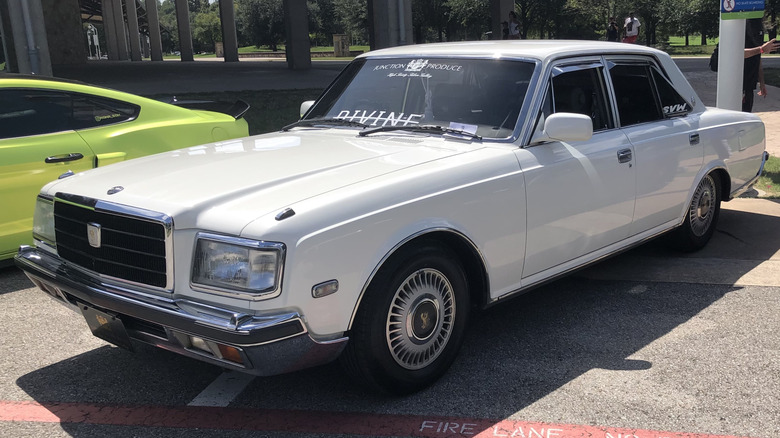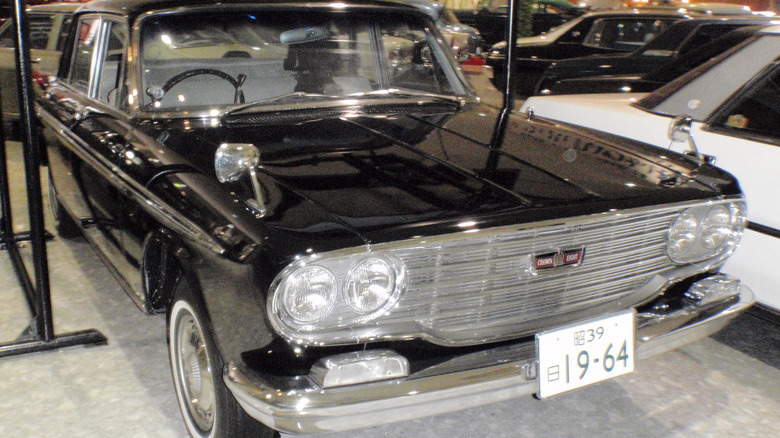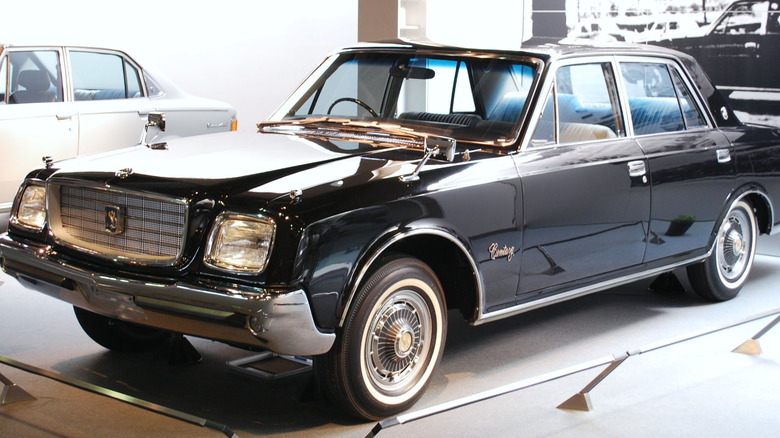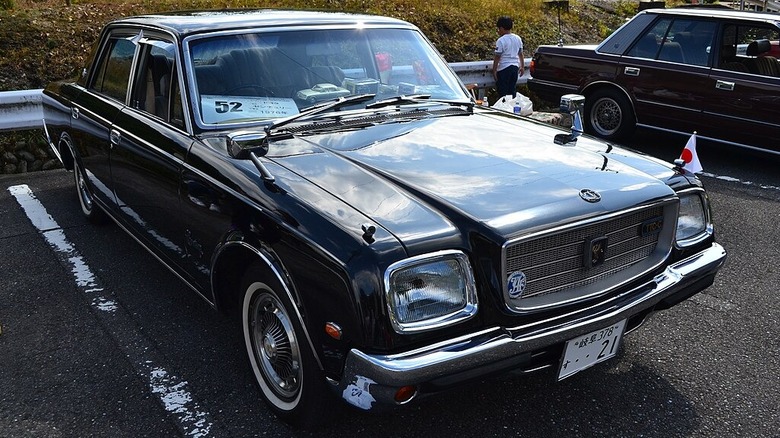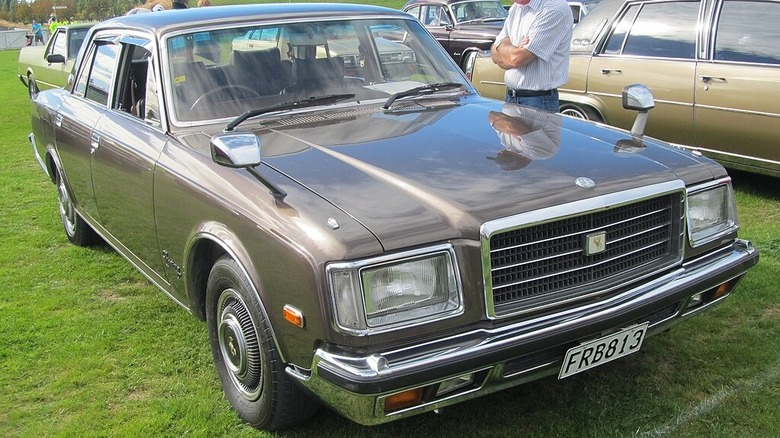Everything You Need To Know About Toyota's Hemi: The V Engine
For decades, Chrysler has had something of a stranglehold on the market when it comes to hemispherical engines. These are engines where the combustion chamber is shaped like a hemisphere, though the actual shape is more hemispherical-adjacent rather than a perfect hemisphere. The reason for this design is to increase the pressure within the chamber more rapidly than that of a more traditional overhead valve or wedge engine. Chrysler has become so synonymous with this kind of engine that it actually called its line of hemispherical engines HEMIs, and for other car manufacturers wanting to make their own hemis, that would be like a company that makes facial tissue trying to compete with Kleenex.
However, other companies have gotten their feet wet in the hemispherical engine pool and had long runs with these engines, even if they aren't as widely popular as Chrysler's. One such company is the Japanese automaker Toyota. For over 30 years, Toyota had its own hemi in production called the V engine, and this series of V8s dates all the way back to the mid-1960s. If you are from the United States, you may be completely unaware that this engine even exists, which would not be surprising thanks to its incredibly limited usage. Let's look back at Toyota's past and examine the rather extensive life of the so-called Toyota hemi and see where exactly it fits in the scope of the company's history.
[Featured image by TKOIII via Wikimedia Commons | Cropped and scaled | CC BY-SA 4.0]
The V engine
The first instance of a V engine appearing under the hood of a Toyota vehicle was all the way back in 1964. Prior to this, Toyota had not really been in the business of vehicles that required a big, impressive V8 engine, but the company was looking to attract customers who wanted a more upscale luxury vehicle. American-made vehicles found their way overseas to fill this market, and those vehicles typically came with the V8 status symbol as well. Toyota wanted to replicate this formula but have it be an entirely Japanese car. This is how we got the Toyota Crown Eight, a luxurious offshoot of the Crown sedan, that would be sold only in Japan.
Being entirely Japanese meant also having a Japanese-made V8 engine, which is not something Toyota had ever dabbled in before. Because of this, Toyota partnered with Yamaha to develop an all-aluminum V8 that would compete with the Chrysler HEMI, which was being revived with the 426 HEMI in 1964 after Chrysler shuttered the FirePower hemi a few years earlier.
With a bore and stroke of 3.07 inches by 2.68 inches, its displacement was 2.6L, which was quite a bit smaller than its competitor (the 426 HEMI equates to 7.0L). It wasn't all that powerful either, generating an output of 114 horsepower and 145 lb-ft of torque. However, that power ended up being perfectly fine for the relatively lightweight Toyota Crown Eight and remained its engine until the car's production was discontinued in 1967.
[Featured image by Kzaral via Wikimedia Commons | Cropped and scaled | CC BY 2.0]
The 3V engine
Production for the Toyota Crown Eight may have stopped in 1967, but that did not mean the days of the V hemi engine were done. Far from it. The reason behind the Crown Eight seeing its last day was that it became the jumping off point for what would become the signature vehicle for Toyota in Japan, the Century. Dubbed as "The Best Car in the World" on a sign at the Toyota production factory, the Toyota Century would utilize the V engine. Despite that kind of status, this car has never really made its way over to the United States in any significant fashion, but in Japan, you can still buy a Century today, though it is now a nameplate for an SUV rather than a luxury sedan.
For the 1967 model, Toyota wanted to improve upon the original V engine. This was done by increasing the stroke length of the previous model to 3.07 inches, perfectly matching the size of the bore to create a square. With this adjustment, the displacement was increased to an even 3.0L and could generate 148 horsepower and 173 lb-ft of torque, far more respectable numbers than the first V engine. This alteration in the engine also gave it a new name, the 3V V8 to signify the larger engine size. The 3V had a much longer run than its predecessor, powering the Toyota Century until 1973.
[Featured image by Mytho88 via Wikimedia Commons | Cropped and scaled | CC BY-SA 3.0]
The 4V engine
When 1973 rolled around, Toyota figured it was time to take the next step with its hemi engine. While the 3V was working, it wanted to make its V8 even larger. Naturally, Toyota would continue with its new naming convention for the V engine line, so the next one out was the 4V engine. Unlike the 3V, this was not a reflection of the engine's displacement but used strictly as a sequential indicator of where it fell in line (which does make the lack of a 2V slightly annoying).
Instead of increasing the stroke to up the displacement volume, Toyota increased the bore to 3.27 inches for a grand total of 3.4L. In terms of output, the 4V was able to handle up to 177 horsepower and 205 lb-ft of torque. Once again, this engine was under the hood of the Toyota Century and was rarely seen outside of Japan. The 4V would be in production for a decade until 1983; however, it evolved a bit over that time.
The original 4V only made it to 1975 because Toyota needed to do some upgrades to it. First, there was the introduction of the 4V-U, which was still the same 3.4L engine except now it was able to meet Japan's emissions standards with a catalytic converter. Three years after that, it was replaced with the 4V-EU, which still met those emissions standards but now also featured electronic fuel injection. That would be the last 4V engine.
[Featured image by 先従隗始 via Wikimedia Commons | Cropped and scaled | CC0 1.0]
The 5V engine
The last of the Toyota hemi engines made its debut in 1983, but it had a production life longer than any of its predecessors. In fact, nearly half the time the V engine line was in production, it was to make the 5V for the Toyota Century as it was utilized by the company all the way until 1997. As you would probably expect, Toyota made the 5V even larger; it was a full 4.0L V8 engine that could generate 188 horsepower and 239 lb-ft of torque. Even by this point, however, the Toyota V engine couldn't hold a candle to the Chrysler HEMI in terms of power, but considering this line of engines lasted over 30 years, everyone seemed to be pleased with it on the whole.
Like the 4V before it, the 5V engine was never just the 5V — it was always the 5V-EU, as it was outfitted with a catalytic converter to meet emissions standards and featured electronic fuel injection. These are codes that Toyota uses to this day to indicate the various elements that distinguish a particular engine.
When 1997 rolled around, Toyota was looking to do a major update on the Toyota Century, which had been home to the V hemi engines for 30 years at that point. Unfortunately, this new update saw the 5V-EU get replaced with the non-hemispherical, gigantic 5.0L 1GZ-FE V12 engine. Because the Toyota Century was really the only vehicle using the V engine, production on the Toyota hemis came to an end.
[Featured image by Riley via Wikimedia Commons | Cropped and scaled | CC BY 2.0]
